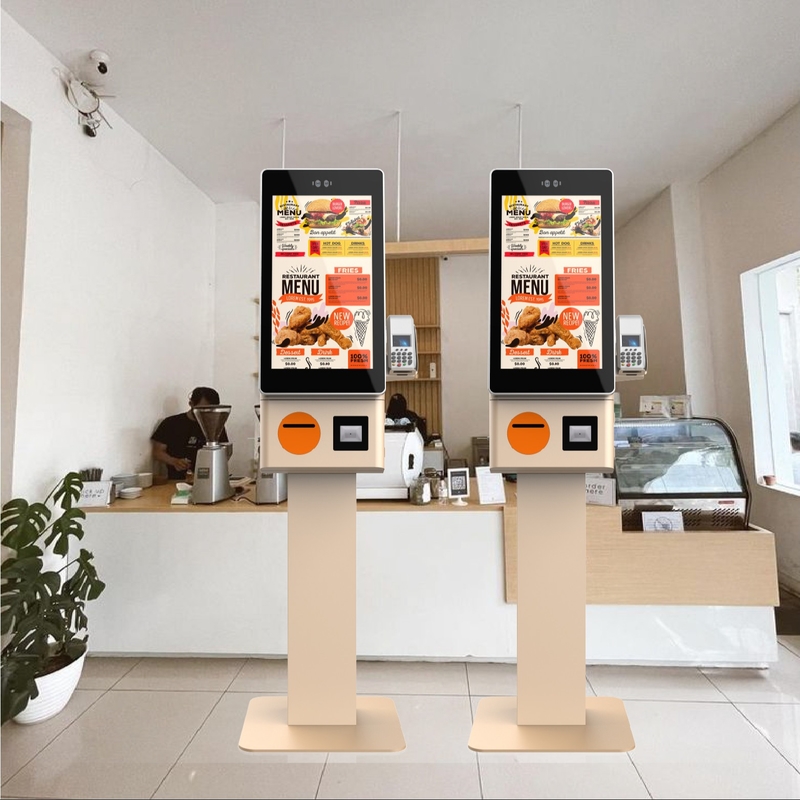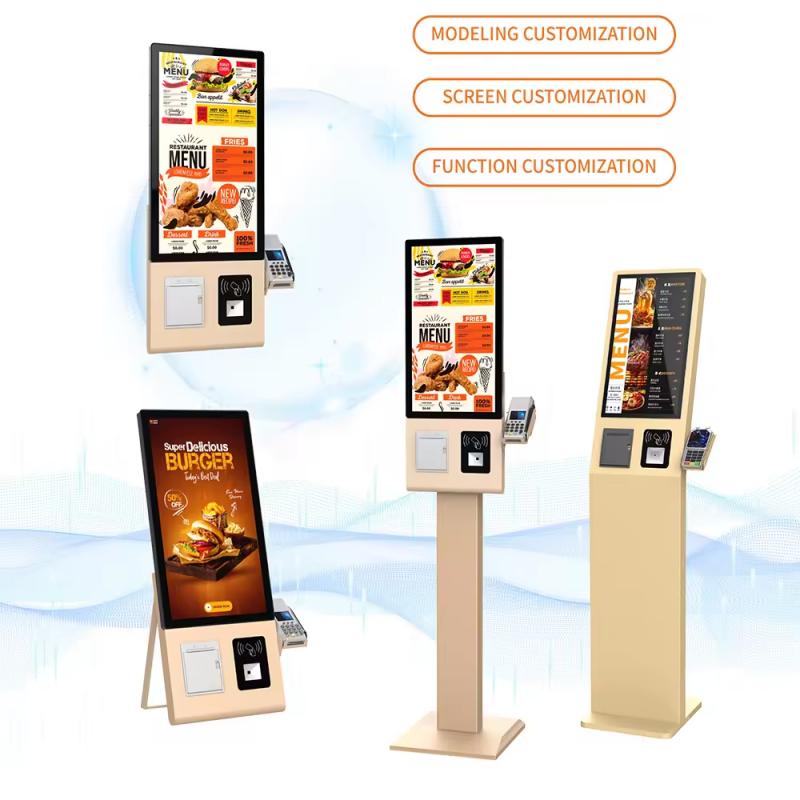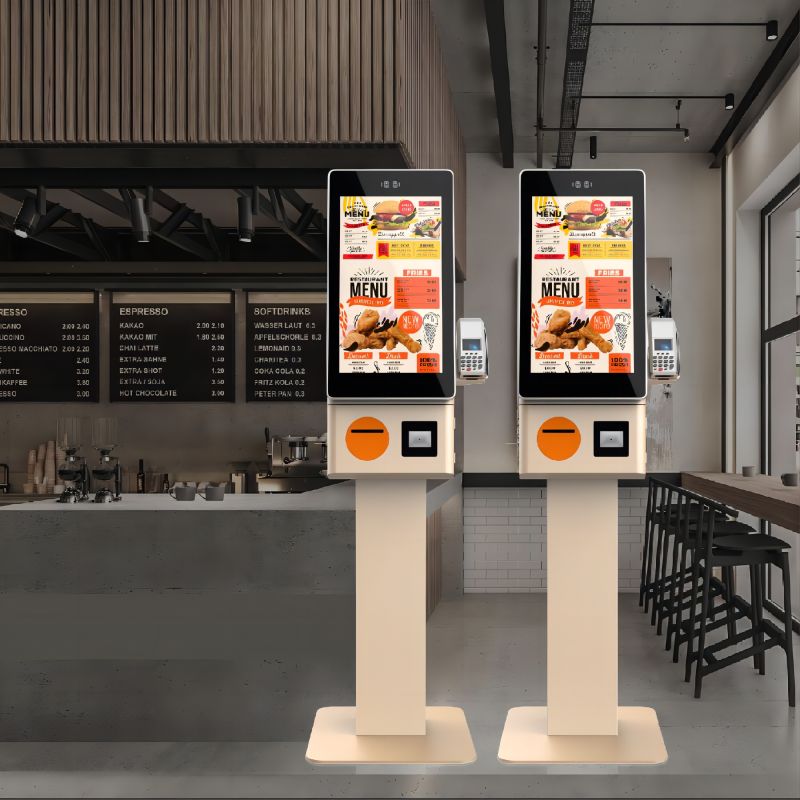





In today's fast-paced world, convenience and efficiency are paramount in payment solutions. The NFC payment kiosk stands at the forefront of this evolution, offering a seamless and secure method for transactions. This article explores the intricacies of NFC payment kiosks, their workings, features, applications, advantages, and future trends, please read it carefully to learn more knowledges about nfc payment kiosk.
An NFC payment kiosk is an advanced self-service terminal that allows users to make payments via Near Field Communication (NFC) technology. This innovative kiosk enables transactions by wirelessly communicating with compatible devices, such as smartphones, smartwatches, and NFC-enabled credit cards. By harnessing RFID (Radio-Frequency Identification) technology, NFC kiosks facilitate quick and contactless payments, enhancing the user experience.

The operation of an NFC payment kiosk involves a sophisticated interaction between the kiosk, the NFC-enabled device, and the backend payment processing systems. Below is a step-by-step outline of this process:
The process begins when a user brings their NFC-enabled device, such as a smartphone, smartwatch, or NFC-equipped payment card, within close proximity to the kiosk's NFC reader. This proximity typically ranges from 1 to 4 centimeters, ensuring a secure and deliberate interaction. The NFC reader inside the kiosk detects the presence of the device and initiates the communication process using RFID (Radio-Frequency Identification) technology.
Once the device is detected, the kiosk and the NFC-enabled device establish a communication link through electromagnetic radio waves operating at the 13.56 MHz frequency band, as defined by the ISO/IEC 14443 standard. This initial handshake is crucial for ensuring that both the kiosk and the device are ready for data exchange. The exchange happens in milliseconds, leveraging short-range wireless communication, which minimizes the risk of interference and unauthorized access.
In active mode, both the kiosk and the user’s device generate their own electromagnetic fields to communicate. This allows the device, such as a smartphone, to actively send payment information, including encrypted authentication details, to the kiosk. Active mode is commonly used in transactions involving smartphones and other electronic devices that have their own power sources, allowing for a more dynamic and high-speed exchange of data.
In contrast to active mode, passive mode is typically used when the user employs a payment card or unpowered NFC token. In this case, the kiosk generates the necessary electromagnetic field that powers the NFC card, enabling it to transmit data back to the kiosk. This passive interaction is extremely energy-efficient, and the card only transmits information when in close proximity to the kiosk, ensuring security by reducing the chance of accidental or unauthorized data transmission.
After communication between the kiosk and the NFC device is established, the core payment transaction begins:
Data Exchange: The kiosk receives the payment data, including details like the transaction amount, device identifier, and encrypted payment credentials.
Encryption and Tokenization: To ensure security, the payment data is encrypted and often tokenized before being sent for processing. Tokenization replaces sensitive information, like the card number, with a unique identifier (token) that can be used for a one-time transaction.
Authentication: Depending on the value of the transaction or the user's device settings, additional authentication may be required. Users may be prompted to authenticate the payment via biometric verification (e.g., fingerprint, facial recognition) or through entering a PIN code. This multi-factor authentication (MFA) layer adds a robust level of security.
Payment Confirmation: Upon successful authentication, the kiosk sends the encrypted payment data to the payment gateway. The payment gateway communicates with the bank or financial institution for real-time authorization. Once approved, the kiosk displays a confirmation message to the user, indicating that the payment has been successfully processed, often within a few seconds.
Once the transaction is completed, the kiosk provides real-time feedback, including visual and audio cues, indicating that the payment is finalized. In many cases, a digital or printed receipt can be issued. Modern kiosks often allow the option to send an e-receipt directly to the user’s email or mobile device.
By diving deeper into the specific steps, it's clear that an NFC payment kiosk utilizes a combination of advanced technologies such as RFID, cryptographic encryption, and real-time data exchange to ensure secure, seamless, and efficient transactions. The entire process is engineered to deliver speed and convenience while adhering to strict security protocols, making NFC payment kiosks a cutting-edge solution in the realm of contactless payments.

NFC payment kiosks incorporate several security layers that ensure safe transactions. Two key technologies are Secure Element (SE) and Host Card Emulation (HCE).
Secure Element (SE): SE is a hardware-based security solution embedded in the device, such as a smartphone or a card, which securely hosts payment applications and encrypts sensitive data. It provides tamper-resistant security, ensuring the integrity of the transaction.
Host Card Emulation (HCE): HCE is a software-based solution that allows NFC-enabled devices to emulate a contactless smart card. While not as secure as SE, it provides flexibility for mobile wallets and allows for cloud-based payment processing, with encryption protocols protecting sensitive data.
To further secure high-value transactions, multi-factor authentication (MFA) is often employed. This could involve a combination of biometric data (fingerprint or facial recognition) and a personal PIN, adding an additional layer of protection against fraud.
NFC operates under global standards like ISO/IEC 14443 and FeliCa, which ensure that devices across the world can communicate effectively. ISO/IEC 14443 governs the interaction between NFC-enabled cards and readers, while FeliCa is widely used in Japan for transit and other transactions. These standards guarantee that NFC kiosks can work with a broad range of devices, ensuring interoperability across various systems and industries.
Compared to other wireless technologies like Bluetooth, NFC is significantly more power-efficient. This makes it an ideal solution for high-traffic environments, such as retail stores or transportation hubs, where users constantly interact with kiosks. The low energy consumption of NFC technology ensures long-term usability without draining the battery life of the devices.
Security: NFC payment kiosks utilize encryption, tokenization, SE, and HCE to protect sensitive data, minimizing fraud risks.
User-Friendly Interface: Designed for ease of use, NFC kiosks feature intuitive navigation, making transactions simple even in high-traffic areas.
Compatibility: These kiosks support a range of devices, including smartphones, smartwatches, and NFC-enabled credit cards, ensuring wide accessibility.
Several industries have successfully implemented NFC payment kiosk. For example, Tokyo's subway system uses NFC kiosk for ticketing, streamlining fare collection for millions of commuters daily. Retail chains like Walmart and Target have adopted NFC kiosks to speed up the checkout process, allowing customers to use their mobile wallets for quick payments, reducing wait times and enhancing the overall shopping experience.
NFC payment kiosks have a variety of applications across multiple sectors:
Retail: Streamlining the checkout process, reducing wait times, and improving customer satisfaction.
Transportation: Used for fare collection and ticketing, allowing commuters to pay effortlessly.
Food and Beverage: Enhancing the ordering experience in restaurants, enabling quick and easy payment processing.

The benefits of implementing NFC payment kiosks are substantial:
Increased Transaction Speed: Customers appreciate the efficiency of completing transactions in seconds, leading to shorter lines and improved service.
Reduced Cash Handling Risks: Minimizing cash transactions lowers the potential for theft and operational costs associated with cash management.
Enhanced Security: With advanced security measures like SE, HCE, and MFA, NFC payment kiosks build consumer trust, encouraging more frequent use.
NFC payment kiosks must comply with various industry standards and regulations, such as PCI DSS (Payment Card Industry Data Security Standard), which governs the secure processing of payment information. Moreover, with global privacy regulations like GDPR (General Data Protection Regulation), these kiosks must also ensure the proper handling and storage of personal data, safeguarding users' privacy.
The success of NFC payment kiosks depends heavily on reliable network infrastructure, whether through Wi-Fi, 4G, or 5G. These connections ensure real-time transaction processing. In high-traffic environments, a robust network can prevent transaction delays, while fallback mechanisms like offline processing can ensure payments are still collected in the event of a network failure.
When selecting an NFC payment kiosk, consider the following factors:
Cost: Evaluate the total cost of ownership, including the initial investment and transaction fees.
Features: Look for essential functionalities like real-time analytics, multi-language support, and customizable options.
Scalability: Choose kiosks that can grow with your business, allowing for future upgrades and enhancements.
The future of NFC payment kiosks looks promising, with several key trends emerging:
Market Growth: The demand for contactless payments continues to rise, driven by consumer preferences for cashless transactions.
Emerging Technologies: NFC kiosks are likely to integrate with IoT (Internet of Things) devices and AI-driven predictive analytics to personalize user experiences. Advancements like blockchain for decentralized payments and biometric authentication for added security will further enhance the user experience.
Increased Consumer Adoption Rates: As awareness of NFC technology grows, more users, particularly younger demographics, will embrace these solutions.

NFC payment kiosks can contribute to a company’s sustainability initiatives. The power-efficient nature of NFC technology reduces energy consumption, while kiosks designed with eco-friendly materials support broader efforts to reduce carbon footprints.
In summary, NFC payment kiosk represents a significant advancement in transaction technology, combining convenience, speed, and robust security features. As businesses look to enhance customer experiences, adopting NFC payment solutions can lead to greater efficiency and satisfaction.
An NFC payment kiosk is a self-service terminal that allows users to make contactless payments using NFC technology.
They employ encryption, tokenization, SE, and HCE to protect sensitive information, significantly reducing the risk of fraud.
These kiosks are compatible with smartphones, smartwatches, and NFC-enabled credit cards.
Yes, many NFC kiosks can seamlessly integrate with current payment systems.
Retail, transportation, and food and beverage industries, among others, benefit from their implementation.
Transactions can be completed in just a few seconds, improving overall customer experience.
They offer speed, security, reduced cash handling risks, and enhanced customer satisfaction.
Look for growth in the market, integration with emerging technologies, and increased consumer adoption.
Address: No. 99-15, Fuan intelligent manufacturing Industrial Park, Dayang Road, Fuhai Street, Baoan District, Shenzhen, China